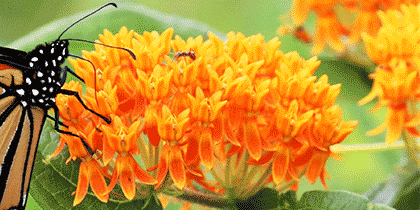Climate Resilient Habitat Increases Ecological Connectivity
Urbanization of natural spaces and accelerated climate change has significantly increased the ongoing loss and fragmentation of wildlife habitat. We can help by restoring natural habitat to increase ecological connectivity and support rapidly disappearing pollinator and other wildlife species.

CREDIT: ANDY RAUPP
Climate Smart Approach to Habitats
Climate-smart gardening and landscaping that factors in the effects of climate change and minimizes our contribution to carbon pollution is an important step in creating sustainable spaces that support wildlife, people, and the health of our ecosystems.
Many of the effects of climate change, including increased frequency and intensity of storms, flooding, drought, and wildfires—as well as range shifts of plants and animals—are all actively changing what plants will survive and thrive in our landscapes. Now, in addition to factors such as sun exposure, shade, soil types, and other site conditions, we must consider the impacts of climate change when we choose plants and in designing our habitat and garden spaces.

CREDIT: FEMA; FOUR TWENTY SEVEN
Throughout our community landscapes, we can create spaces that not only support local wildlife now, but that will also help wildlife as they face increasing challenges from the impacts of climate change over the next several decades. Later is too late.
“A recent study reported wildlife friendly yards used about 50 gallons of water per day on average, while yards with conventional lawns used up to 200 gallons per day.”
Source: Evapotranspiration of residential lawns across the United States. Water Resources Research, 59, e2022WR032893
By replacing invasive nonnative plants, and lawns, with a mix of diverse native plants that bloom through multiple seasons, property owners and community members can create resilient habitats year round to benefit both people and wildlife.











